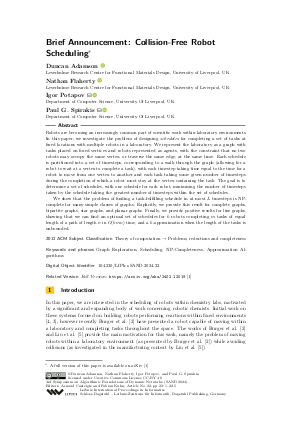Brief Announcement: Collision-Free Robot Scheduling
Authors
Duncan Adamson  ,
Nathan Flaherty
,
Nathan Flaherty  ,
Igor Potapov
,
Igor Potapov  ,
Paul G. Spirakis
,
Paul G. Spirakis 
-
Part of:
Volume:
3rd Symposium on Algorithmic Foundations of Dynamic Networks (SAND 2024)
Part of: Series: Leibniz International Proceedings in Informatics (LIPIcs)
Part of: Conference: Symposium on Algorithmic Foundations of Dynamic Networks (SAND) - License:
 Creative Commons Attribution 4.0 International license
Creative Commons Attribution 4.0 International license
- Publication Date: 2024-05-31
File

PDF
LIPIcs.SAND.2024.22.pdf
- Filesize: 0.62 MB
- 5 pages
Document Identifiers
Related Versions
- Full Version https://arxiv.org/abs/2402.12019
Subject Classification
ACM Subject Classification
- Theory of computation → Problems, reductions and completeness
Keywords
- Graph Exploration
- Scheduling
- NP-Completeness
- Approximation Algorithms
Metrics
- Access Statistics
-
Total Accesses (updated on a weekly basis)
0PDF Downloads0Metadata Views
Abstract
Robots are becoming an increasingly common part of scientific work within laboratory environments. In this paper, we investigate the problem of designing schedules for completing a set of tasks at fixed locations with multiple robots in a laboratory. We represent the laboratory as a graph with tasks placed on fixed vertices and robots represented as agents, with the constraint that no two robots may occupy the same vertex, or traverse the same edge, at the same time. Each schedule is partitioned into a set of timesteps, corresponding to a walk through the graph (allowing for a robot to wait at a vertex to complete a task), with each timestep taking time equal to the time for a robot to move from one vertex to another and each task taking some given number of timesteps during the completion of which a robot must stay at the vertex containing the task. The goal is to determine a set of schedules, with one schedule for each robot, minimising the number of timesteps taken by the schedule taking the greatest number of timesteps within the set of schedules. We show that the problem of finding a task-fulfilling schedule in at most L timesteps is NP-complete for many simple classes of graphs. Explicitly, we provide this result for complete graphs, bipartite graphs, star graphs, and planar graphs. Finally, we provide positive results for line graphs, showing that we can find an optimal set of schedules for k robots completing m tasks of equal length of a path of length n in O(kmn) time, and a k-approximation when the length of the tasks is unbounded.
Cite As Get BibTex
Duncan Adamson, Nathan Flaherty, Igor Potapov, and Paul G. Spirakis. Brief Announcement: Collision-Free Robot Scheduling. In 3rd Symposium on Algorithmic Foundations of Dynamic Networks (SAND 2024). Leibniz International Proceedings in Informatics (LIPIcs), Volume 292, pp. 22:1-22:5, Schloss Dagstuhl – Leibniz-Zentrum für Informatik (2024)
https://doi.org/10.4230/LIPIcs.SAND.2024.22
BibTex
@InProceedings{adamson_et_al:LIPIcs.SAND.2024.22,
author = {Adamson, Duncan and Flaherty, Nathan and Potapov, Igor and Spirakis, Paul G.},
title = {{Brief Announcement: Collision-Free Robot Scheduling}},
booktitle = {3rd Symposium on Algorithmic Foundations of Dynamic Networks (SAND 2024)},
pages = {22:1--22:5},
series = {Leibniz International Proceedings in Informatics (LIPIcs)},
ISBN = {978-3-95977-315-7},
ISSN = {1868-8969},
year = {2024},
volume = {292},
editor = {Casteigts, Arnaud and Kuhn, Fabian},
publisher = {Schloss Dagstuhl -- Leibniz-Zentrum f{\"u}r Informatik},
address = {Dagstuhl, Germany},
URL = {https://drops.dagstuhl.de/entities/document/10.4230/LIPIcs.SAND.2024.22},
URN = {urn:nbn:de:0030-drops-199004},
doi = {10.4230/LIPIcs.SAND.2024.22},
annote = {Keywords: Graph Exploration, Scheduling, NP-Completeness, Approximation Algorithms}
}
Author Details
- Leverhulme Research Centre for Functional Materials Design, University of Liverpool, UK
- Leverhulme Research Centre for Functional Materials Design, University of Liverpool, UK
References
- Duncan Adamson, Nathan Flaherty, Igor Potapov, and Paul Spirakis. Collision-free robot scheduling, 2024. URL: https://arxiv.org/abs/2402.12019.
-
B. Burger, P. M. Maffettone, V. V. Gusev, C. M. Aitchison, Y. Bai, X. Wang, X. Li, B. M. Alston, B. Li, R. Clowes, et al. A mobile robotic chemist. Nature, 583(7815):237-241, 2020.

-
R. D. King. Rise of the robo scientists. Scientific American, 304(1):72-77, 2011.

-
J. Li, S. G. Ballmer, E. P. Gllis, S. Fujii, M. J. Schmidt, A. M. E. Palazzolo, J. W. Lehmann, G. F. Morehouse, and M. D. Burke. Synthesis of many different types of organic small molecules using one automated process. Science, 347(6227):1221-1226, 2015.

-
S. Liu, J. Shen, W. Tian, J. Lin, P. Li, and B. Li. Balanced task allocation and collision-free scheduling of multi-robot systems in large spacecraft structure manufacturing. Robotics and Autonomous Systems, 159:104289, 2023.

